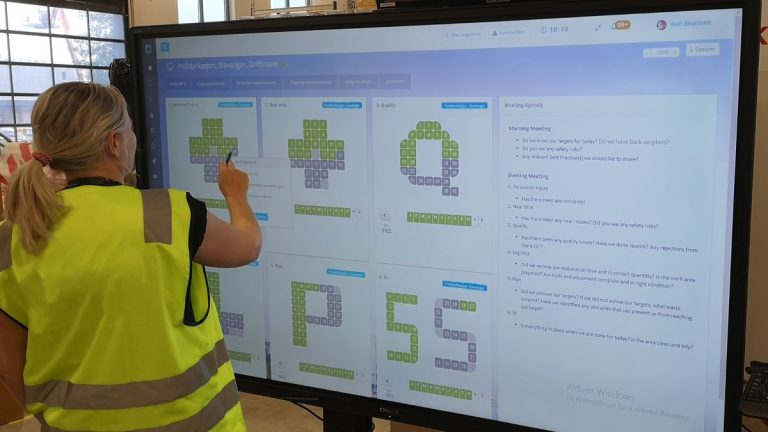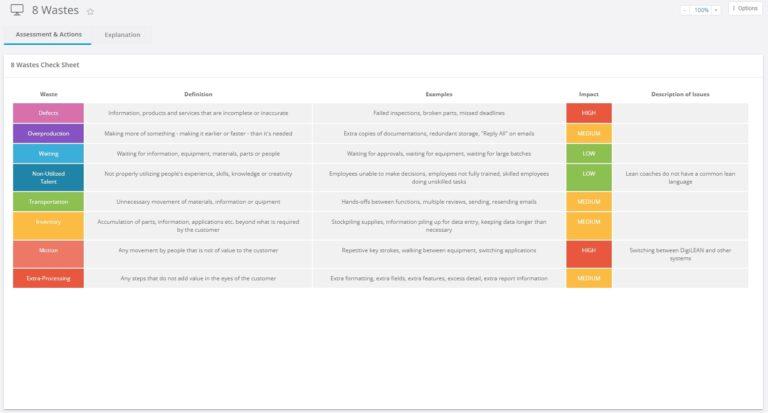- Product
Interactive boards. Fully customizable.
Capture, prioritize and follow up improvements.
Report and manage incidents. Visualize reports and statistics.
Operationalize your strategies and integrate your whole organization.
Access your tools in Microsoft Teams.
Customized templates. Problem solving, business development etc.
Manage project individually or in portfolios with visual and interactive tools.
Create and share best practices, one-point-lectures and standards.
Easy access to tasks, improvements and incidents.
Integrate DigiLEAN with your existing IT systems.
Meeting the demand of larger organizations.
High security level by default.
In less than 4 min
- Use Cases

Interactive tools for both shop floor and administration.
Visual project management.
Maintain standards. Manage incidents and discrepancies.
Manage tasks, integrate with problem-solving and continuous improvement.
Lean daily management tailored for healthcare.
Team task management, problem-solving and visualization.Case management, improvements, problem-solving, and strategy alignment.We have a LEAN solution for you too. Just ask!
We meet the demand of larger organizations.
- Pricing
- Shop Floor
- Product
Interactive boards. Fully customizable.
Capture, prioritize and follow up improvements.
Report and manage incidents. Visualize reports and statistics.
Operationalize your strategies and integrate your whole organization.
Access your tools in Microsoft Teams.
Customized templates. Problem solving, business development etc.
Manage project individually or in portfolios with visual and interactive tools.
Create and share best practices, one-point-lectures and standards.
Easy access to tasks, improvements and incidents.
Integrate DigiLEAN with your existing IT systems.
Meeting the demand of larger organizations.
High security level by default.
In less than 4 min
- Use Cases

Interactive tools for both shop floor and administration.
Visual project management.
Maintain standards. Manage incidents and discrepancies.
Manage tasks, integrate with problem-solving and continuous improvement.
Lean daily management tailored for healthcare.
Team task management, problem-solving and visualization.Case management, improvements, problem-solving, and strategy alignment.We have a LEAN solution for you too. Just ask!
We meet the demand of larger organizations.
- Pricing
- Shop Floor
What Are The 8 Wastes of Lean Manufacturing?
Understanding the 8 wastes of lean manufacturing helps you reduce waste in your processes. More effective processes, higher quality and fewer defects makes your business more competitive.
Once you have the basic knowledge, you can identify, categorize and reduce wastes in your production. This enables you to manage your business with more structure and control.
So, what are the 8 wastes of lean manufacturing?
Defects
Defects occur when the part is outside specifications, damaged, or scrapped.
This can have various consequences and implications.
- You have to make the part again. The extra effort is not adding any more value.
- Production variance and reduced flow.
- Delays, either on this part, or other parts.
- There is also an environmental impact whenever scrapped material is trashed.
Overproduction
Overproduction is not only producing too many parts and piling up the stock inventory. It’s also a matter of producing too early, not aligning production steps (Takt and flow), or producing with extensive quality. This is not adding value for the customer, nor are you getting paid for it.
Multiple lean principles apply here. Just-in-Time, Voice of Customer, Takt time, flow.
What cause overproduction?
- Variance in production flow and process
- Customer escape
- Unclear customer need or specification
- Inaccurate forecasting
- Sub-optimized production control
Transportation
Internal transportation, movement of parts in the factory cause waste. A poorly designed production layout cause unnecessary transportation of parts from one stage to another. This activity is not a value-adding activity, and must be minimized.
Optimizing the factory layout according to the production process helps reduce the need to move parts, and reduce the need for extra equipment and accessories, and the maintenance on this as well.
Excess Processing
Poorly defined responsibilities, lack of communication or processes can cause activities to overlap. It results in tasks being done twice, or you spend extra time to double-check, clarify or verify.
Avoiding poor communication, having clear and functional process descriptions, well-defined responsibilities help streamline the process, and avoid excess processing.
Re-visit or create a value stream map to identify your activities, and assess how each part adds value in the process, and how non-value adding processing is minimized.
Motion
This type of waste relates to production processes, factory layout and 5S. It’s a waste whenever the workers take more steps than necessary.
Take 5S for example. Keeping the necessary tools available at the work station. If the worker has to walk extensively to pick up a tool used frequently, it’s a good idea to move the tool closer to the workplace. And if multiple workers use the tool, perhaps get a second tool, one for each.
The same example relates to the transport waste. With extensive transport, you get extensive movement. None of which adds value to the customer.
To reduce the waste of motion, work stations and tools placement must align with the workflow.
Waiting
Waiting for parts, raw material, information, specifications, documents, people are examples of waste. Waiting is a cost and doesn’t add value for the customer.
It’s a symptom of a bottleneck in your process, or it’s caused by an unwanted event such as machine breakdowns.
To identify causes for unwanted waiting, study the value stream map, measure production steps’ timing, and perform root cause analysis.
Inventory
Without a streamlined value chain, and you purchase more raw materials than you are planning to use, the inventory cost increases. Inventory is tying up capital without being converted to products and sales. It takes up more space in your warehouse. It can get messy, and you spend more time finding other materials and items for your production.
The causes are much the same as for overproduction:
- Poor scheduling or forecasting
- Poor value stream alignment
- Unscheduled stops
- Uneven production
Non-Utilized Talent
An operator’s job description is normally very specific, and mainly consist of repeatable activities and simple responsibilities. However, frontline workers are intellectual beings, and have some level of desire to influence and improve their surroundings.
When an organization is not utilizing this human and intellectual capital, it’s considered a waste.
Leaders should learn their employees’ competence, motivation and desires, and facilitate building an army of problem solvers. Give them the tools and knowledge to identify and make improvements, and they will feel empowered. The frontline workers know best the difficulties that exist, and also have good ideas on how to best solve them.
Talents will grow and bloom, and help strengthen the lean and learning culture.
© 2025 DigiLEAN AS

